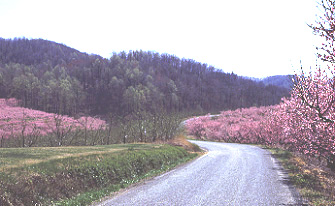
White Peach Scale, Pseudaulacaspis pentagona
(Targioni-Tozzetti)
I. Introduction: The white peach scale (WPS)
is a native of the Orient that was introduced into
Georgia in the late 1800's. In the U.S. it is primarily a pest in the
deep South, but has also occurred in southern Virginia. A related scale, white prunicola scale (Pseudaulacaspis prunicola (Maskell))
also infests peach. It was formerly included with white peach
scale, but occurs in more northern parts of the range (NY, etc.).
But there is broad overlap in both host and geographic range; both
occur on Prunus (and other genera) in VA, WV and MD. The best way
to differentiate is in slide-mounted specimens. The spines on the
edge of the last abdominal segment are forked in WPS, and simple in white prunicola scale (Kosztarab 1996).
II. Hosts: It is most common on peach, but will also attack
other stone fruits. It feeds on several
hundred other plant species, including privet, mulberry, chinaberry,
and flowering cherry.
III. Description: The adult female is a creamy-white to
reddish-orange sac-like insect about
4/100 inch (1 mm) in diameter. Each female is covered by a waxy scale
that is oval to circular, grayish
to brownish-white, and 1/10 inch (2-2.5 mm) in diameter. The adult male
is a tiny, yellow, two-winged
insect <4/100 inch (<1 mm) long. Immature males are covered with
an elongate, snowy white scale about
6/100 inch (1.5 mm) long. Eggs, which are laid underneath the scale
covering, are orange (females) or
pink (males). Nymphs (crawlers) are tiny, oval, and white to orange
with six legs.
IV. Biology: WPS overwinters on the tree as a fertilized female
beneath the scale covering. Beginning
at the petal fall stage of peach, each female lays 100-150 eggs over a
one month period, with hatch occurring
in about 10 days. Following egg hatch, crawlers immediately leave the
scale covering and move to new sites
to begin feeding on the bark. In about a week after settling down to
feed, crawlers begin forming a scale
covering. Male scales cluster in large numbers on the trunk and
scaffold limbs so as to completely cover
the bark and give the tree a "whitewashed" appearance. Female scales
tend to disperse throughout the
tree, but are seldom seen on terminal, green wood. Females remain under
the scale covering throughout
their life. Males develop wings when mature, emerge from their scale
covering, and seek out and mate
with females. There are 3 generations per year in Virginia, with second
and third generation crawlers
present in July and from late August through September, respectively.
V. Injury: Scale feeding removes sap from the tree which reduces
vigor. Foliage of infested trees
may become sparse and yellow. Fruit size may be reduced and premature
drop is likely to occur, especially f scale feeding is accompanied by
other stress. Heavy infestations can result in the death of twigs,
branches, and even trees if left unattended for 2 to 3 years.
VI. Monitoring: Monitor crawler emergence with black
electrician's tape wrapped around scale
infested branches with the sticky side out. A thin coating of petroleum
jelly will enhance and extend
the tape's effectiveness in capturing crawlers. Monitoring should be
conducted after harvest to detect
the third generation. There are no thresholds for WPS.
Additional References:
Kosztarab, M. 1996. Scale Insects of Northeastern North America:
Identification, Biology and Distribution. Va. Museum Nat.
Hist. Spec. Pub. No. 3. 650 p.
This is taken primarily from a chapter by H. W.
Hogmire and D. F. Polk on peach indirect pests,
reprinted with permission from Mid-Atlantic Orchard Monitoring Guide,
published
by
NRAES,
152 Riley-Robb Hall, Ithaca, New York 14853-5701. (607)
255-7654.
Back to Virginia
Peach
page
Back to Virginia Fruit
Page
